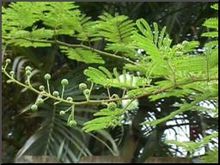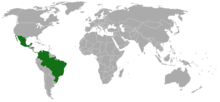- Mimosa tenuiflora
-
Mimosa tenuiflora 
Mimosa tenuiflora Scientific classification Kingdom: Plantae (unranked): Angiosperms (unranked): Eudicots (unranked): Rosids Order: Fabales Family: Fabaceae Subfamily: Mimosoideae Genus: Mimosa Species: M. tenuiflora Binomial name Mimosa tenuiflora
(Willd.) Poir.[1][2]
Range of Mimosa tenuiflora Synonyms Mimosa tenuiflora (Jurema, Tepezcohuite) is a perennial evergreen tree or shrub native to the northeastern region of Brazil (Paraíba, Rio Grande do Norte, Ceará, Pernambuco, Bahia) and found as far north as southern Mexico (Oaxaca and coast of Chiapas).[3] It is most often found in lower altitudes, but it can be found as high as 1000 m.[3]
Contents
Description
The fern-like branches have leaves that are Mimosa like, finely pinnate, growing to 5 cm long. Each compound leaf contains 15-33 pairs of bright green leaflets 5-6 mm long. The tree itself grows up to 8 m tall[3] and it can reach 4–5 m tall in less than 5 years. The white,[3] fragrant flowers occur in loosely cylindrical spikes 4–8 cm long. In the Northern Hemisphere it blossoms and produces fruit from November to June or July.[4] In the Southern Hemisphere it blooms primarily from September to January. The fruit is brittle and averages 2.5–5 cm long. Each pod contains 4–6 seeds that are oval, flat, light brown and 3–4 mm in diameter. There are about 145 seeds/g.[5] In the Southern Hemisphere, the fruit ripens from February to April.
The tree's bark is dark brown to gray. It splits lengthwise and the inside is reddish brown.
The tree's wood is dark reddish brown with a yellow center. It is very dense, durable and strong, having a density of about 1.11 g/cm³.[6]
Mimosa tenuiflora does very well after a forest fire, or other major ecological disturbance.[7] It is a prolific pioneer plant.[7] It drops its leaves on the ground, continuously forming a thin layer of mulch and eventually humus. Along with its ability to fix nitrogen, the tree conditions the soil, making it ready for other plant species to come along.
Medicinal uses
Disaster response
 Mimosa tenuiflora root bark
Mimosa tenuiflora root bark
The Mayans of Mexico have used roasted Mimosa tenuiflora "tepezcohuite" bark to treat lesions of the skin for over a thousand years.[8]
Powdered tepezcohuite bark contains large amounts (16%) of tannins, which act as an astringent, making the skin stop bleeding. This helps protect the body from infection, while the skin builds new protective tissue.[citation needed]
Tannins in the bark diminish capillary permeability.[disambiguation needed
 ] It contains antioxidant flavonoids.
] It contains antioxidant flavonoids.Mimosa tenuiflora "tepezcohuite" proved vital in the treatment of some of the 5000 burn victims in the aftermath of a series of liquid petroleum gas explosions at a huge facility located near Mexico City in San Juan Ixhuatepec (San Juanico), November 19, 1984.[9] It was also used to treat victims of a large 1985 earthquake in Mexico.[9] Powder from the bark has a 2-3 hour pain killing effect on the skin. Bark powder causes skin to regenerate fully in a matter of weeks.[9][not in citation given] The results and some mechanisms thereof have been confirmed in the laboratory.[9] Tepezcohuite is used to treat acne, psoriasis and herpes.[10]
Extensive research has been performed in labs in Mexico, Canada and the United Kingdom.[citation needed] It is now used in commercial hair and skin products that claim to rejuvenate skin. The bark is known to be rich in tannins, saponins, alkaloids, lipids, phytosterols, glucosides, xylose, rhamnose, arabinose, lupeol, methoxychalcones and kukulkanins. In vitro studies have shown three times more bacteriocidal activity on bacterial cultures than streptomycin, and it works to some degree in vivo.[citation needed]
In addition to the above effects, tepezcohuite may protect and stimulate the generation of collagen and "elastina," as well as providing protecting flavonoids and hyaluronic acid, a building block for tissue regeneration.[citation needed]
Treating traumatic injury
For traumatic injuries, tepezcohuite is believed to protect exposed bone and to help regenerate soft tissue. As mentioned before, it is an antiseptic. It is also used to prevent inflammation.[11]
Treating venous leg ulcerations
Mimosa tenuiflora has been shown to be very effective in treating venous leg ulcerations, a condition especially problematic for people with diabetes.[12]
Other
A tea made of the leaves and stem is used to treat tooth pain.[13]
For cases of cough and bronchitis, a water extract (decoction) of Mimosa tenuiflora is drunk.[14] A handful of bark in one liter of water is used by itself or in a syrup.[14] The solution is drunk until the symptoms subside.[14]
Other uses
The tree is an acceptable source of forage or fodder for animals, providing vital protein and other nutrients.[7] It does well in the dry season and in drought, while providing life saving food for local livestock and animals.[7] Cows, goats and sheep eat the pods and leaves. There seems to be evidence that Mimosa tenuiflora forage or fodder is teratogenic to pregnant ruminants in Brazil.[15][16]
The tree is an important source of forage for bees, especially during the dry season and in the beginning of the wet season.
Like most plants in the Fabaceae family, Mimosa tenuiflora fertilizes the soil via nitrogen fixing bacteria.[17] The tree is useful in fighting soil erosion and for reforestation.
Mimosa tenuiflora is a very good source of fuel wood and works very well for making posts,[17] most likely because of its high tannin content (16%), which protects it from rot. It is used to make bridges, buildings, fences, furniture and wheels. It is an excellent source of charcoal and at least one study has been done to see why this is the case.[18]
The bark of the tree has a high tannin content of about 16%[19] making it is widely used as a natural dye and in leather production.
The healing properties of the tree make it useful in treating domestic animals. A solution of the leaves or bark can also be used for washing animals in the prevention of parasites. Because the tree keeps most of its leaves during the dry season, it is an important source of shade for animals and plants during that time.
Entheogenic uses
Mimosa tenuiflora is an entheogen known as Jurema, Jurema Preta, Black Jurema, and Vinho de Jurema. Dried Mexican Mimosa tenuiflora root bark has been recently shown to have a DMT (Dimethyltryptamine) content of about 1%.[3] The stem bark has about 0.03% DMT.[20] The bark is the part of the tree traditionally used in northeastern Brazil in a psychoactive decoction also called Jurema or Yurema. Analogously, the traditional Western Amazonian sacrament Ayahuasca is brewed from indigenous ayahuasca vines. However, to date no β-carbolines such as harmala alkaloids have been detected in Mimosa tenuiflora decoctions, yet the root bark is consistently used without added MAOI.
This presents challenges to the pharmacological understanding of how DMT from the plant is rendered orally active as an entheogen. In this view, if MAOI is neither present in the plant nor added to the mixture, the enzyme MAO will break apart DMT in the human gut, preventing the active molecule from entering blood and brain.
The isolation of a new compound called "Yuremamine" from Mimosa tenuiflora as reported in 2005 represents a new class of phyto-indoles,[21] which may explain an apparent oral activity of DMT in Jurema.
Propagation
For outside planting, USDA Zone 9 or higher is recommended.[22]
In nature, Mimosa tenuiflora "[...] fruits and seeds are disseminated by the wind in a radius of 5–8m from the mother plant; rain carries them from slopes to lower plains and human activities contribute to their dissemination."[23]
For cultivation, the seed pods are collected once they start to spontaneously open on the tree. The collected pods are laid out in the sun so that the pods open up and release their seeds. The seeds can then be planted in sandy soil with sun exposure.
Scarification of the seed via mechanical means or by using sulfuric acid greatly increases the germination rate of the seeds over non-treatment.[23] The seeds can be sown directly into holes in the ground or planted in prepared areas.
The seeds can germinate in temperatures ranging from 10 to 30 °C, but the highest germination rate occurs at around 25 °C (about 96%), even after four years of storage.[23] Germination takes about 2–4 weeks.
It is also possible to propagate Mimosa tenuiflora via cuttings.[3]
Trimming adult Mimosa tenuiflorae during the rainy season is not recommended because it can cause them to perish.[6]
See also
References
- ^ "Acacia tenuiflora - ILDIS LegumeWeb". www.ildis.org. http://www.ildis.org/LegumeWeb?sciname=Acacia+tenuiflora. Retrieved 2008-04-20.
- ^ "Mimosa tenuiflora information from NPGS/GRIN". www.ars-grin.gov. http://www.ars-grin.gov/cgi-bin/npgs/html/taxon.pl?24430. Retrieved 2008-05-04.
- ^ a b c d e f Rätsch, Christian. Enzyklopädie der psychoaktiven Pflanzen. Botanik, Ethnopharmakologie und Anwendungen.. Aarau: AT-Verl.. p. 15. ISBN 978-3855025701.
- ^ Camargo-Ricalde SL (December 2000). "[Description, distribution, anatomy, chemical composition and uses of Mimosa tenuiflora(Fabaceae-Mimosoideae) in Mexico]" (in Spanish; Castilian). Rev. Biol. Trop. 48 (4): 939–54. PMID 11487939.
- ^ "Mimosa hostilis (Jurema Preta) in Profile". www.b-and-t-world-seeds.com. http://www.b-and-t-world-seeds.com/72975.html. Retrieved 2008-05-04.
- ^ a b "Kew: Northeast Brazil Fuelwood Project - activities and progress". www.kew.org. http://www.kew.org/scihort/tropamerica/fuelwoodprojects.htm. Retrieved 2008-05-05.
- ^ a b c d "Pesquisa Agropecuária Brasileira - Forage yield and quality of a dense thorny and thornless "jurema-preta" stand". www.scielo.br. http://www.scielo.br/scielo.php?script=sci_arttext&pid=S0100-204X2007000300006&lng=entarget=_blanktarget=_blank&nrm=iso&tlng=entarget=_blanktarget=_blank. Retrieved 2008-04-19.
- ^ "GRAIN | Briefings | 2000 | Of patents & pi®ates". www.grain.org. http://www.grain.org/briefings/?id=141. Retrieved 2008-04-20.
- ^ a b c d Chemistry, Biological and ... - Google Book Search. books.google.com. 1999. ISBN 9789057023972. http://books.google.com/?id=plBoBL5_jqMC&pg=PA61&dq=%22mimosa+tenuiflora%22+dimethyltryptamine. Retrieved 2008-04-20.
- ^ "Nursery ARVE, Juchitan, Oax". 209.85.171.104. http://209.85.171.104/translate_c?hl=en&langpair=es%7Cen&u=http://istmored.com/Vivero/nativa2.html. Retrieved 2008-05-04.
- ^ Chemistry, biological and ... - Google Book Search. books.google.com. 1999. ISBN 9789057023972. http://books.google.com/?id=plBoBL5_jqMC&pg=PA79&lpg=PA79&dq=medicinal+uses+of+%22mimosa+tenuiflora%22. Retrieved 2008-05-09.
- ^ Rivera-Arce E, Chávez-Soto MA, Herrera-Arellano A et al. (February 2007). "Therapeutic effectiveness of a Mimosa tenuiflora cortex extract in venous leg ulceration treatment". J Ethnopharmacol 109 (3): 523–8. doi:10.1016/j.jep.2006.08.032. PMID 17088036.
- ^ "Table 1". www.ethnobiomed.com. http://www.ethnobiomed.com/content/2/1/30/table/T1. Retrieved 2008-05-09.
- ^ a b c "Divulga��o". 66.102.1.104. http://66.102.1.104/scholar?hl=en&lr=&ie=UTF-8&safe=off&q=cache:eKF_BsM_PxcJ:www.artigocientifico.com.br/uploads/artc_1180581455_38.pdf+medicinal+use+of+%22mimosa+tenuiflora%22. Retrieved 2008-05-09.
- ^ Medeiros RM, de Figueiredo AP, Benício TM, Dantas FP, Riet-Correa F (February 2008). "Teratogenicity of Mimosa tenuiflora seeds to pregnant rats". Toxicon 51 (2): 316–9. doi:10.1016/j.toxicon.2007.06.012. PMID 18078971.
- ^ Pimentel LA, Correa FR, Gardner D et al. (November 2007). "Mimosa tenuiflora as a cause of malformations in ruminants in the northeastern Brazilian semiarid rangelands". Vet. Pathol. 44 (6): 928–31. doi:10.1354/vp.44-6-928. PMID 18039908.
- ^ a b "Exploitation of the potential of multipurpose trees and shrubs in agroforestry". 66.102.1.104. http://66.102.1.104/scholar?hl=en&lr=&ie=UTF-8&safe=off&client=firefox-a&q=cache:9L7cmykFFZkJ:www.worldagroforestry.org/units/library/books/PDFs/07_Agroforestry_a_decade_of_development.pdf%23page%3D282+%22Mimosa+tenuiflora%22. Retrieved 2008-04-20.
- ^ "Lazaro Benedito da Silva". 66.102.1.104. http://66.102.1.104/scholar?hl=en&lr=&ie=UTF-8&safe=off&q=cache:sf8P-mZgYhwJ:www.rbgkew.org.uk/science/tropamerica/Prance_reports/Lazaro_Silva.doc+%22mimosa+tenuiflora%22. Retrieved 2008-04-20.
- ^ Rivera-Arce E, Gattuso M, Alvarado R et al. (September 2007). "Pharmacognostical studies of the plant drug Mimosae tenuiflorae cortex". J Ethnopharmacol 113 (3): 400–8. doi:10.1016/j.jep.2007.06.023. PMID 17709219.
- ^ "Ayahuasca Library > Ott 1998 - Pharmahuasca, Anahuasca and Vinho da Jurema". google.com. http://google.com/search?q=cache:ZyYZFwoM8bIJ:www.santodaime.it/Library/NATURALSCIENCES/ott98a_english.htm+mexican+%22mimosa+tenuiflora%22+seeds&hl=en&ct=clnk&cd=19&gl=us&ie=UTF-8&client=firefox-a. Retrieved 2008-05-04.
- ^ Vepsäläinen JJ, Auriola S, Tukiainen M, Ropponen N, Callaway JC (November 2005). "Isolation and characterization of yuremamine, a new phytoindole". Planta Med. 71 (11): 1053–7. doi:10.1055/s-2005-873131. PMID 16320208.
- ^ "Mimosa hostilis from B & T World Seeds". www.b-and-t-world-seeds.com. http://www.b-and-t-world-seeds.com/carth.asp?species=Mimosa%20hostilis&sref=72975. Retrieved 2008-05-04.
- ^ a b c "Revista de Biología Tropical - Germinación, dispersión y establecimiento de plántulas de Mimosa tenuiflora (Leguminosae) en México". www.scielo.sa.cr. http://www.scielo.sa.cr/scielo.php?pid=S0034-77441998000300007&script=sci_arttext. Retrieved 2008-04-20.
External links
- Erowid mimosa page
- New research paper on Mimosa tenuiflora"
- Camargo-Ricalde SL (December 2000). "[Description, distribution, anatomy, chemical composition and uses of Mimosa tenuiflora(Fabaceae-Mimosoideae) in Mexico]" (in Spanish; Castilian). Rev. Biol. Trop. 48 (4): 939–54. PMID 11487939.
- Mimosa tenuiflora USDA
- Forage yield and quality of a dense thorny and thornless "jurema-preta" stand
Wikimedia Foundation. 2010.
